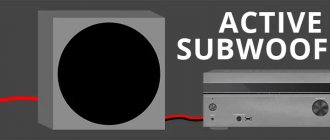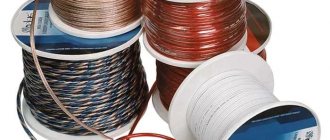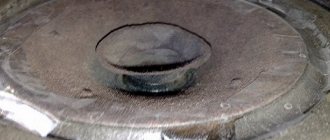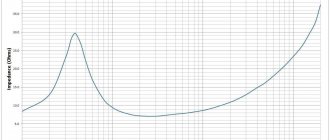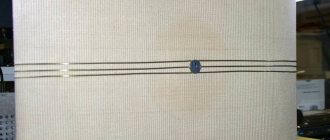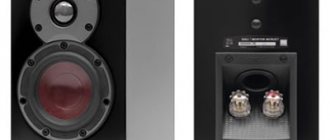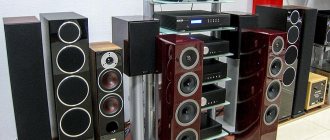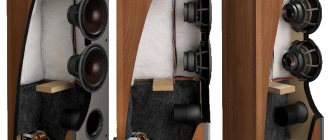Don't know the difference between active and passive speakers? We'll tell you
Save and read later -
At its simplest, a traditional hi-fi system consists of a source, an integrated amplifier and a pair of passive speakers. So far everything is pretty clear.
But if we consider the signal path, it turns out that it can be divided into an even larger number of separate sections, many of which are mixed with each other in this simple system.
Active speakers or powered speakers
Powered speakers are also known as powered speakers. Powered speakers have most, if not all, of the electronics built into the cabinet, making them easy to set up and use. You simply plug in the main unit and connect it to your music source, and you're connected to a high-quality sound system.
Powered speakers have a lot of hidden technology, and they often include built-in Wi-Fi or Bluetooth technology, making them very convenient for playing music from a wide variety of sources. And since there's no need for a receiver, you have a neater, simpler setup.
Sound
Active speakers are designed to work as a unit, so using active speakers means that the sound will come from components that are designed to work together. This means you'll get optimized, high-quality audio from the start, which is a valuable asset.
Manufacturers ensure that the integrated amplifier can accommodate a wide range of speakers and that the amplifier and drivers work perfectly together. The powered speaker options available on the market today include some very impressive technology.
Flexibility
With powered speakers, the user has less control over the sound and additional features. You can't easily add components, so if you want to improve a certain aspect of the sound with a popular amp, it may not be possible.
For this reason, it is important that you choose powered speakers that embody the sound you are looking for, without any additional components or technology.
Signal path
In the case of powered speakers, the signal path begins with the music source - such as a computer, record player, CD player, etc., then the path goes to the preamplifier, which controls the source and volume level. After the preamplifier, the path passes through the crossover of the active speaker.
In an active speaker crossover, the signal operates at a linear power level of about 2 volts, which is an advantage and helps create more accurate sound. After the crossover network, the signal passes through special power amplifiers for each drive.
TOP 5 – “wireless” active acoustics 2.0 for home
Conclusion
Yamaha NX-N500 active bookshelf monitors cannot boast of booming bass, they do not have grills and are not equipped with booster stands for desktop placement.
But they have fantastically rich functional equipment, and most importantly, sharp, detailed and very clear “monitor” sound. And the output power is fine! With such a ratio of price, sound quality and capabilities, it is not surprising that these speakers have surpassed almost all competitors in the rating. Price – 220,000 rubles.
The concept of creating “wireless” speakers Dynaudio Xeo is in many ways similar to the approach of competitors. Here, too, a worthy model is taken as a basis (in this case, Dynaudio Excite X34 passive floor-standing speakers), which is equipped with a high-quality built-in amplifier and appropriate electronics to implement additional functions. However, this is where the similarities end. Wanting to make the audio path as “correct” as possible, Dynaudio designers did not install a switching panel in the active speakers. This allowed us to solve two problems at once: now there are no wires reaching the speakers even from stationary sources, and there are no wires between the speakers. If the buyer has the opportunity to provide a 220 Volt outlet behind each Xeo 6, then he will be able to enjoy the purity of the visual image: only these turrets will be visible! But where to connect the sources? To the separately purchased Dynaudio Xeo Hub. The compact device is equipped with two analog stereo inputs (3.5 mm and 2 x RCA), optical and electrical S/PDIF, an Ethernet port for integration into a local network (Wi-Fi is also supported) and USB type B for connecting to a computer in external DAC mode. In all cases, a digital signal with a bit depth of up to 24 bits and a sampling frequency of up to 96 kHz is allowed. Unfortunately, there is no support for PCM 24/192, PCM DXD and DSD. As well as the ability to stream music via Bluetooth directly from a smartphone or tablet. But in this case, we are glad that the manufacturer did not engage in populism, but immediately excluded the objectively weak link from the chain. After all, as you know, even with support for the aptX codec on both devices, the sound quality when playing any soundtrack via Bluetooth is somewhere between MP3 320 kbps and PCM 16 bit / 44.1 kHz (Audio CD). On high-end Dynaudio Xeo 6 speakers this would be immediately audible. Therefore, the manufacturer has left only that method of wireless signal transmission that does not reduce the quality of the music. However, we hope that after the mass adoption of the aptX HD codecs from Qualcomm and LDAC from Sony, their support will appear in one of the next generations of the Xeo line. So, having received a digital or analog signal from the source, the Xeo Hub unit sends it to the speakers wirelessly in uncompressed form. The noise immunity of the system is very high! And the “range” of the transmitter is up to 50 meters inside a building. If this turns out to be not enough, you can use intermediate signal amplifiers. In any case, it is important not to forget to set a number of settings using the toggle switches on the rear panel of each speaker. This is a channel (left, right or mono), an installation zone (in the “multiroom” configuration of Dynaudio Xeo there can be up to 3 independent zones) and an installation method (against a wall, in a corner or in a free field). The last setting allows you to optimize the frequency response. As for the sound quality, traditional laudatory epithets are hardly appropriate. Compared to all the other models in this review, the Dynaudio Xeo 6 is like a Rolls-Royce compared to a typical city car. The sound is of a completely different class, and this is manifested in all aspects - from power (here bandpass amplification is used with an output of 150 W per speaker versus 30-70 W for competitors), accuracy and bass depth (the lower limit at the -3 dB level is 31 Hz versus 50-70 Hz for competitors) - up to the sound resolution and the ability of the speakers to build a detailed and very voluminous scene. Dynaudio Xeo 6 is a very serious component stereo system, “packed” into a pair of active floor-standing speakers 85 cm high and weighing 15 kg each. However, even in terms of price, these speakers seem like a Rolls-Royce compared to their competitors. But if you put aside emotions and do the math, it turns out profitable. After all, a pair of floor-standing passive speakers Dynaudio Excite X34, a separate amplifier, a stand for it and cables can cost even more, simultaneously ruining the entire aesthetics of the buyer and depriving the guarantee of sound compatibility that an active system provides. So the price of the Xeo 6 doesn’t seem like it was taken out of the blue. In our laboratory we previously tested Dynaudio Xeo 5, a model of the previous generation. The results can be found at the link
.
Pros:
Excellent full-bodied sound, wireless signal transmission from different sources (analog, PC, network resource) to speakers without loss of quality up to 24 bit / 96 kHz, solid finish, speakers are not connected by wires, convenient control and clear indication, possibility of integration into "multi-room" environment.
Minuses:
You cannot stream music from a portable gadget via Bluetooth (only through a router, via DLNA); decoding of PCM digital audio streams above 24 bit / 96 kHz and DSD is not supported.
Passive speakers
Passive speakers are usually included in a traditional stereo system, and their overall setup is completely different from active speakers. Passive speakers do not have a built-in amplifier like active speakers and therefore require an external power amplifier to power the speakers, such as a receiver or a separate component.
Passive speakers are most often found for home use. Because this type of system has more components, it can be more difficult to set up, and once you set it up, you usually don't move it around after that. The overall installation is also less tidy due to more wires to connect each component to each other.
Sound
Passive speaker components are customized and selected, so the sound quality depends on who selects the components. This may mean that you can select the best components of each class for any purpose, but will they sound clean and optimized together?
It depends on how much you know about connecting the various components to each other. Sometimes it can be difficult to pair different components. If you need help choosing speakers, check out our speaker buying guide!
They are very flexible
With passive speakers, you can easily disable or upgrade components at will. You have much more control over your sound system, allowing you to create a completely customizable system, which is highly desirable for many audiophiles. You can build your system piece by piece, as you go, or all at once.
More complex and complex signal path
The passive signal path is slightly different from the active signal path. In passive speakers, the signal path begins with the music source, then, as with the active signal path, it goes to the preamplifier to determine the source and volume level.
The signal is sent to a power amplifier, which then drives the speakers through a speaker crossover network. This allows the sound to be divided into several parts depending on the type of speakers it drives.
The speaker crossover network in a passive system operates at the speaker level - typically 15 to 35 volts.
Keep in mind that the preamp and amplifier are built into the A/V receiver. Therefore, the signal path is sound source > receiver > loudspeaker(s).
Is there a difference between powered and powered speakers?
Powered speakers are also known as powered speakers, and all powered speakers are powered. But when it comes to active speakers, not all of them are considered active.
Active speakers have the same configuration as passive speakers, but unlike passive speakers, one of the active speakers has both a preamplifier and a power amplifier built into the cabinet.
So you'll see an extra wire between the two speakers that allows the main amplified speaker to connect its passive speaker counterpart to the built-in amplification component.
Active speakers
More precise crossover filter provides better sound matching
In an active system, everything is exactly the same until the signal leaves the preamplifier. It is then passed to an active crossover filter, which does the same job as a passive crossover, but does so with a line level signal (around 2V) rather than the one that drives the speakers (typically 15-35V ).
Working with a low-level signal allows components to be optimized for accuracy rather than power. This design usually uses active elements, and in more complex models, some types of signal processing circuits (digital or analog) to emit the highest quality sound from the speakers.
As a result, such a filter potentially provides greater precision in operations while also helping to create an optimal and consistent sound.
The line level signal of each frequency subband is then sent to a separate power amplifier, which powers as many speakers as are allocated to reproduce that band.
Which is better: active or passive speakers?
General
Passive speakers have many advantages. You have more flexibility in the placement of your components. It's an easier system to upgrade and replace components, and you have much more control over the sound.
There are also many benefits to being active speakers. The amplifier and speakers are designed to work together to produce clearer, clearer, and more reliable sound. Installation is simple, neat and easy, and many are configured for wireless applications.
When it comes to active and passive speakers, the overall winner really depends on the individual, but active speakers tend to make more of a difference. If you want more control over the sound and components, passive speakers are probably your best choice. For a complete system with reliable, high-quality sound that you don't want to mess around with, powered speakers are the best option.
According to the script
Powered speakers are a clear winner for music on the go, such as portable Bluetooth speakers. Powered speakers are also an excellent choice for bands and public organizations such as restaurants, bars, clubs, churches or schools, as they come ready to use with high-quality professional sound.
Passive speakers are an excellent choice for large-scale installations such as DJs and live events, where you want to add a subwoofer or additional components to create fully immersive sound for a large area or crowd.
Because the components are heavy, they are best installed once or moved occasionally, which also makes them a great choice for home theaters.
Which option is better?
The sound of speakers with an active crossover is less susceptible to distortion
In theory, active speakers consist of only advantages. The crossover design principle gives their designers much greater control over the signal, and also creates much less opportunity for errors and distortion compared to similar passive filters.
Because the power amplifiers are built into the speakers, they can be optimized for each individual speaker. And because they are usually located directly in the cabinet, the length of cables between amplifiers and speakers can be reduced, resulting in lower levels of distortion and loss in them. In other words, the result is maximum control.
However, despite such serious advantages of active speakers, they are not without drawbacks. Not every speaker manufacturer produces amplifiers, so they are usually purchased ready-made from OEM suppliers. This principle in itself is not bad, but practical implementation is not always successful. As a result, the sound quality of the finished speaker is far from ideal.
In addition, active speakers are inferior to passive ones in a store's sales area in terms of subjective perceived value. Electronic components are hidden in the housing, and the price difference compared to similar-looking passive competitors is visible to the naked eye. When you break down the cost of built-in components, powered speakers are usually a better deal because they include multiple power amplifiers—even a simple two-way pair of speakers requires four amplification units, whereas a single stereo amplifier can drive all four speakers in a passive system.
Active designs also limit the range of possible upgrades. Instead of upgrading the power amplifiers, you will have to change the entire set. For those who like to combine options, this sharply narrows the room for maneuver: a set of power amplifiers and speakers is either suitable or not.
Examples of Great Active and Passive Speakers
Now that you know the pros and cons, pros and cons of active and passive speakers, your next step is to find the right ones for you. Here are some of the best active and passive speaker options for different purposes.
Active
- Edifier R1700BT Bluetooth Bookshelf Speakers (on Amazon)
- Klipsch R-51PM Powered Bluetooth Speaker (on Amazon)
- KEF LS50 Mini Monitor (pair on Amazon)
Passive
- JBL Professional JRX200 series
- Electro-Voice ZLX12P 15" 2-Way 1000W Powered Speaker (on Amazon)
- Yamaha DBR10 700W Active Speaker (on Amazon)
Hopefully you are now more aware of what type of speakers are suitable for your current and future use. Have a question? Leave a comment and as always, enjoy your viewing!
Recording source: https://thehometheaterdiy.com

